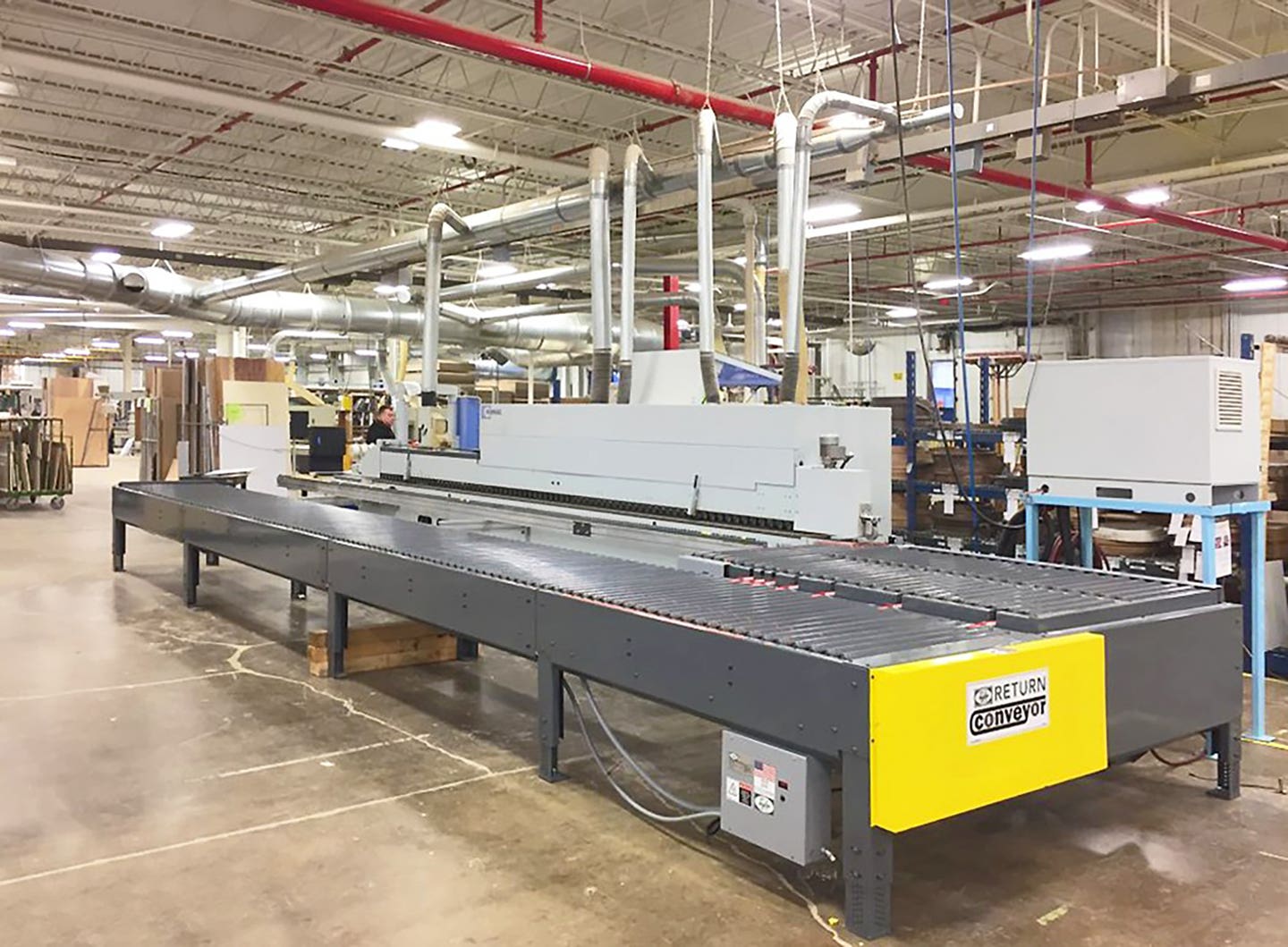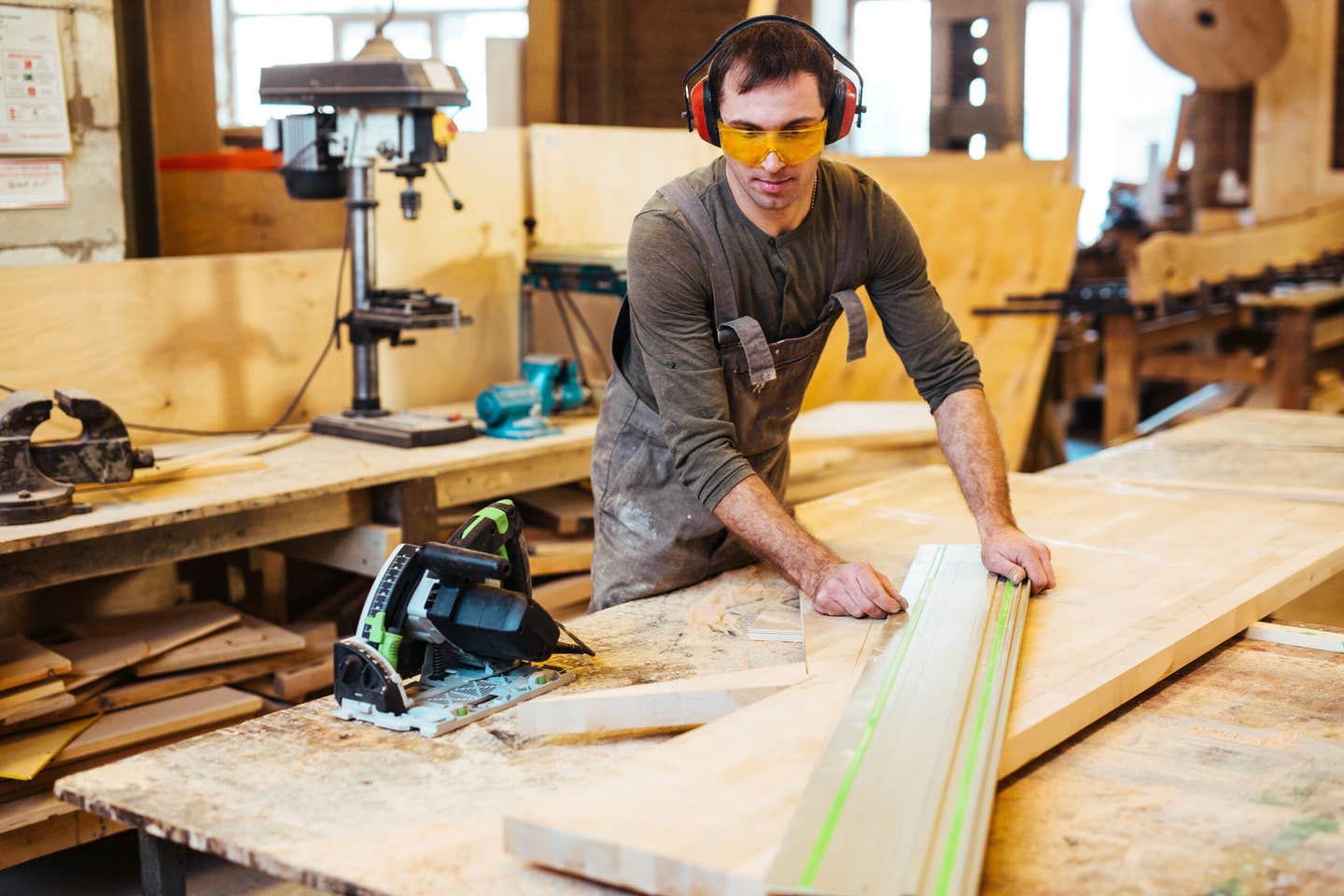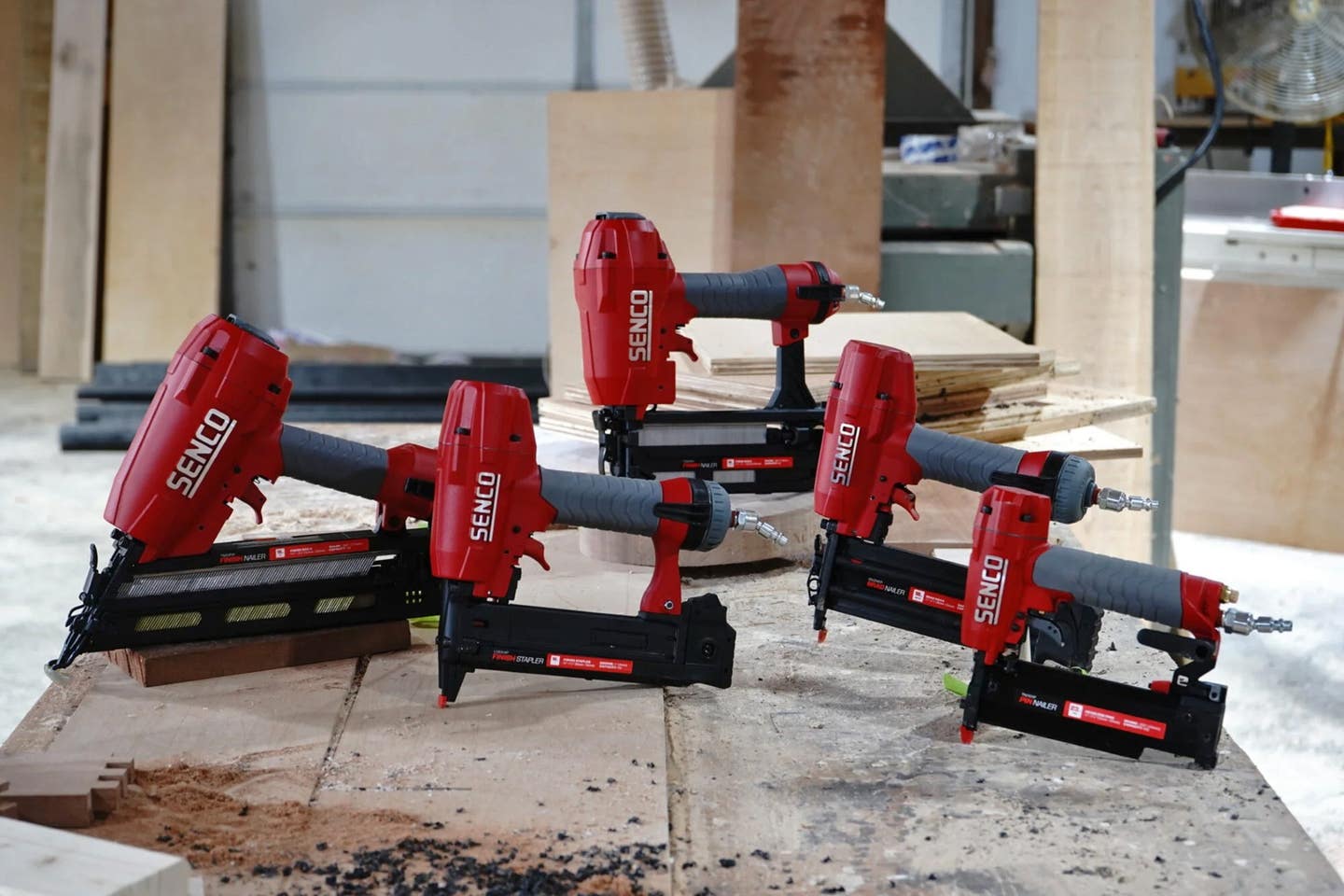A life-changing calculation
Southern California native W. Patrick Edwards chose woodworking over a career as a nuclear physicist. He was building rocket guidance systems one day and felt he was forced to make…
Southern California native W. Patrick Edwards chose woodworking over a career as a nuclear physicist. He was building rocket guidance systems one day and felt he was forced to make a decision. His passion for antiques, marquetry and working with hand tools won out.
"If you have passion for something, it's all you want to do," says Edwards, who runs two businesses out of his San Diego shop. One is called Antique Refinishers Inc., which provides restoration and conservation of pre-industrial American and European furniture for private collectors, dealers and institutions. The other is the American School of French Marquetry Inc., which offers public classes in traditional 18th century French marquetry techniques.
His well-established portfolio features a large collection of marquetry projects. He swears by the French form, which requires a unique horizontal cutting tool, the "chevalet de marqueterie," or marquetry cutting easel.
An innately motivated researcher and travel enthusiast, Edwards worked his way into the woodworking and antiquing niche by teaching himself. He traveled to the East Coast dozens of times in the late 1960s while an undergraduate in college, visiting the Winterthur Museum, Garden & Library in Wilmington, Del., Thomas Jefferson's Monticello in Charlottesville, Va., and other venues to study period furniture collections. Prior to this calling, he had embarked on a completely different career.
From atoms to antiques
Edwards was born in Los Angeles in 1948. The only woodworker in his family was his great-grandfather, a master carpenter with an interstate lumber company in Montana that went broke during the Great Depression.
"My father always wanted me to be somebody that he could brag about, so I was encouraged to study nuclear physics because I was good at it. I took physics and calculus. In high school, I built an atom smasher at the science fair and took the sweepstakes - at that point my life changed because I had a choice of going to the national science fair or to Europe and ride a bike."
He picked Europe, where he competed in races and took every opportunity to absorb the culture. Edwards then enrolled in the first freshman class at the University of California-San Diego, where he majored in nuclear physics and minored in history. On weekends, he restored antique furniture pieces and sold them for as much as $2,000. Then he started teaching about antiques and devouring books on the subject during his free time. This didn't sit well with his boss at Maxwell Labs, a government research facility, who wanted a completely focused nuclear physicist, so Edwards quit and became an antiques dealer.
"There was an amazing demand for antique furniture during the bicentennial years and it was very profitable to pick them up in the East and sell them in the West," he says. "I had no trouble supporting my family and paying for a house. The business was quite profitable. When I first started, in those first six months, I thought I'd be an antique store and sell inventory. I realized that didn't work because you had to put a lot of capital on the floor and you had to rotate your capital frequently. You also had to sit there and wait for the buyer - that was too risky. Changing the profile of the business to restoration meant that my income was 90 percent labor and 10 percent materials."
Yearning for more avenues in the antique field in order to grow his business, he delved into a research project at the University of Delaware's Winterthur Summer Institute studying regional American furniture from 1800-1850. The idea stemmed from his leisurely reading of antique books at the library. Something was lacking. They all seemed to stop at about 1820.
His research led him to Yale University and an important meeting with Charles Montgomery, author of "American Furniture: The Federal Period" (Winterthur Book). Montgomery was one of the first researchers to discuss regional influences on furniture design and encouraged Edwards to join the pursuit.
Edwards completed an unpublished master's thesis on style influences of American furniture from various cultures, including French, German and English. It discussed predictions as to where those cultural influences were moving in America. By analyzing the different regions of immigration, developing transportation routes and early government statistics that documented the trades relating to furniture, it provided a map of the regional characteristics of furniture made in the first half of the 19th century east of the Mississippi.
His antiques business continued to grow and evolve through the 1980s. He was building and repairing furniture, teaching, and consulting collectors and enthusiasts about the intricacies of antiques - their history, value and evolution. By then, he gained a well-respected reputation and was looked at as an authority in the field.
All word of mouth
The majority of Edwards' clients are in upscale neighborhoods of San Diego and Los Angeles. He has consulted and worked for several historic homes, large museums and important collections in private hands. Past jobs include restoration work at the California Capitol building in Sacramento, the San Diego Museum of Man at Balboa Park, and for the California Historical Society at the Whittier Mansion in San Francisco.
Edwards says he has never seen any value in advertising. His clients and his work provide all the promotion he needs. Since his business is focused on a very specialized service and commands a high price, he relies on quality and not quantity to survive.
"My advertisement is my work. The difficulty with that is a lot of what I do is what a plastic surgeon does - you don't want it to be visible. My clients pay me a lot of money to do work which is not obvious to the normal observer."
He explains that he follows the guidelines of the American Institute for Conservation of Historic and Artistic Works, which requires that the casual observer not be able to see the restoration from a distance of six feet. However, a sophisticated analyst would be able to identify it at a distance of six inches. This prevents the appearance of fraud and allows museums, dealers and collectors to determine the condition and authenticity.
Edwards has invested in a first-class website and keeps a blog at www.wpatrickedwards. blogspot.com.
"My website was getting old and I wanted to start producing a journal which would communicate my day-to-day activities in a more user-friendly method. I look forward to creating an entry each day I come to work," he says.
Montgomery also taught Edwards how to charge effectively for his time in order to make a profit. He was encouraged to study the concept of production, profit and productivity, and the use of formulas in work price books used in the 19th century.
"I learned if I'm going to use hand tools to recreate a Chippendale, I only have so many hours to do it. Since I knew exactly how the antique was made and I had all the antique tools to do it, all I needed was to know how long it took the original craftsman to make it. The price guides, which were used in the first decades of the 19th century, provided this information. I wrote an article on this subject for the Society of Period Furniture Makers, which was published in their 2003 Volume 3 edition under the title "Period Productivity."
"You have to know your productivity. Therefore, you should get one of those lawyers' time books broken up into every 15 minutes of the day and write everything down. Is it shop time? That's zero. If it's client time, then you can bill for it. Then look over the time book at the end of the year and find what you are actually making per hour. Learn your efficiency rate and then factor in your overhead and profit margin. To stay in business, you need to be able to bill enough hours per day of work to cover your costs and projected profit."
The division of labor
Edwards spends at least four hours per day on restoration work. Several more hours are devoted to research, client procurement and site visits. His remaining shop time is committed to producing spec pieces and commissions, the most profitable elements of his business.
Additionally, Edwards offers consulting services to assist in the evaluation of antique furniture. Collectors and appraisers in the field value his self-motivated experience in pre-industrial European and American furniture. He provides condition reports, detailing structural or decorative repairs or modifications that directly affect value. Authentication reports, which include age dating of wood certificates using molecular spectroscopy, are offered as well.
Though he swears he's "not one for designing," Edwards has a keen aptitude to re-create work. The word re-create should be emphasized, he says. The term "copy" is negative. Reproduction is also inappropriate, he says, as it implies the work was a production piece to begin. One of the benefits of re-creating the earlier pieces is that there are no copyrights on antique furniture.
"If I re-created a trademark or copyright that is controlled, I couldn't do that, but pre-industrial antiques are not copyrighted so I can go to any book and pick out any type of furniture from 1780, for example, and re-create it. I give credit to whoever made it if I know, but I'm re-creating his work."
One reason that Edwards gravitated into marquetry is because he says there's no market in his location for the East Coast recreations.
"On the West Coast, the clients want European, Spanish, French, German and Italian furniture. And the best way to make that is high-end marquetry. I can decorate a surface and put high-end veneer on it, and make a lot of money."
Off to Paris
Edwards first learned of marquetry back in the 1970s when a designer from Hollywood encouraged him to bid on a job for a 4'x15' table for a client in Houston. Edwards said he'd charge $20 an hour and asked for supply of maple to make his veneer press and materials to build a chevalet. A chevalet de marqueterie, or cutting horse, was unique to the French trade and the only way he knew how to do it.
In 1991, Edwards enrolled in École Boulle, an advanced public school of fine arts and crafts and applied arts in Paris, to study marquetry under Dr. Pierre Ramond. Spending three months each year for four years, Edwards completed studies in marquetry and French polish and became the only accredited workshop in North American to receive students from École Boulle. His affiliation with his professor led to his casual teaching of exchange students and the opening of The American School of French Marquetry in 2000.
There are two one-week classes, offered four times a year, which focus on basic introduction to the French method of marquetry. His shop has eight chevalets of different sizes, so enrollment is limited to six to eight students at a time. The majority of students are from the U.S., but others have come from across the globe.
"The purpose of the school is to teach students the use of the chevalet, which is completely unknown in this country. The tool has to be fit to your body. It's the only cutting tool in the world that uses a horizontal blade. Everyone else uses a vertical blade for marquetry."
Where's the table saw?
Located in a mildly busy commercial neighborhood, Edwards' shop is situated on a quiet side street. The outside looks like a welcoming two-story home. The front entrance is about 500-sq.-ft. and features a plethora of antiques, many being Edwards' latest repair projects. A walk to the back of the building passes through a room with a large workbench, followed by an office and large assembly room. The second floor is dedicated primarily to the school.
Very little work is subcontracted. Edwards does any required caning, upholstery, carving, turning and finishing. Edwards' wife, Kristen Arrivee, is the bookkeeper. Patrice Lejeune, a graduate of École Boulle and a partner in Edwards' corporation, works on color matching and finishing, including French polish, as well as traditional furniture making and modern marquetry projects.
Edwards has an extensive hand-tool collection, including more than 850 wood block hand planes (mostly American and pre-Civil War) and about 450 English Sheffield chisels. The few power tools include a 1952 Shopsmith, used only as a lathe, Delta band saw, Ryobi miter saw and DeWalt planer. Edwards has never owned a table saw or a router.
He uses mahogany as his primary wood, culled mainly from a personal stash stockpiled in the '70s and '80s. He's using European beech, tulip poplar and white oak as a secondary wood. He once used Honduran mahogany, but its availability is almost gone. He expresses disappointment in the availability of secondary woods on the West Coast.
"The woods I can't get are American black cherry and good quality walnut. Everyone's swimming in it on the East Coast, but not out here, so I'm really limited. That's why I like veneers. I have a good collection of veneers, which I purchase in Paris, and I only used sliced material, which is 1/28th (0.9mm) thick or sawn material which is 1/16" (1/5mm)."
For marquetry and other assembly applications, Edwards encourages the use of animal protein glue, which he says is a central part of his success. He says synthetic glues contain toxins that affect the finish. Alternately, the animal protein glue provides a strong hold with molecular bonding. He contributed another article for the Society of American Period Furniture Makers' Journal, Volume 2, 2002, titled "Why Not Period Glue?" After years of research into modifying protein glues, he formulated a natural liquid hide glue, Old Brown Glue, which has enjoyed increasing acceptance among woodworkers.
Future plans
Edwards can still keep busy for seven days a week, even though last year was as difficult a time for him as it was for everyone else. He once enjoyed a six-month backlog that has dwindled to six weeks. He still has the high-end clientele, but the middle class customers have disappeared.
"The normal middle-class projects have slowed down as the real estate market changed," he says. "Typically, by the end of November, I would have two or three dining tables to refinish for middle-class homes. I don't see those middle-class jobs in this recession and it may be some time before they return."
There seems to be security with the high-level market. Edwards is currently working on several commissions for jewelry chests, joking that those who can afford expensive jewelry can afford expensive furniture.
Still calculating the use of his shop time as effectively as possible, Edwards is concerned that any time focused on bringing in work subtracts from his productive time in the shop. He is now channeling his efforts toward his school and lectures.
"The recession makes me want to increase my school effort because there's been an increase in the desire for self education. I'm also investigating going back to teaching decorative arts at a college level because I haven't done that consistently since 1983."
Edwards is also active in Preserving the Arts and Sciences of the Trades, a tool collecting club, and the San Diego Fine Woodworkers Association. For a decade, 1985 to 1995, he was state superintendent of the guild's Design in Wood show, which is the country's largest juried public woodworking show.
"I'm not planning any major downsize or upgrade. I have a large inventory of furniture collected over the years and it's always my intention to bring them out and restore them. I recently got to that point and have been pulling things out that I've collected over 30 years to work on for resale.
"Since I received my last paycheck, working in the physics industry in 1973, I have never looked back. Learning physics made me smart; restoring antiques makes me happy."
Contact: W. Patrick Edwards, 3815 Utah St., San Diego, CA 92104. Tel: 619-298-0864. www.wpatrickedwards.com
This article originally appeared in the November 2010 issue.







